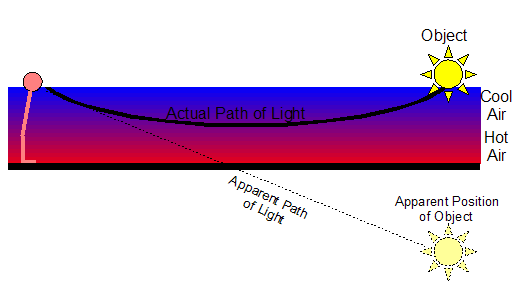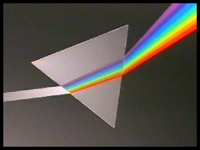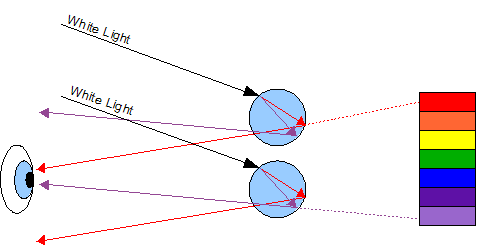The refraction of light also leads to some other interesting effects. We will look at two of them in this lesson: mirages and the dispersion of light.
- This is not the end of the list for “weird” things light will do. Instead, this is just an introduction for you.
Mirages
Mirages are virtual images caused by a large refraction of light as it travels through the air.
- You might have seen a mirage while looking at a distant part of the road on a hot day.
- Did it look kind of like it was shimmering, almost like there was water on the surface of the road?
This can only happen if very specific conditions are met.
- The air near the ground is heated up by the sun’s heat warming up the ground (this is why we often see it above a road, which as a nearly black surface absorbs thermal energy easily).
- A few metres above the ground the air is much cooler.
- The different temperatures of the air results in different densities for the layers of air. This results in each air layer having a different index of refraction!
Light being refracted from an object will make it appear as though it is being reflected off the surface of the ground.
- If the sun is in front of you, then you will see the shimmering image of sunlight. Since it might be slightly distorted or even polarized, your brain interprets it as "water".
- Our eyes and brain always assume that light is traveling in a straight line. Even if it isn’t, we have no way of knowing.

Dispersion
If you look again at Snell’s Law, you’ll see that the angle a beam can be refracted can depend on its wavelength.

- What the formula shows us is that colors with smaller wavelengths have a higher index of refraction than colors with long wavelengths.
- Because the light is made up of different colors that are going through different indicies of refraction, they are being refracted at different angles. The colors of light split into the colours of the rainbow... an effect called dispersion.
You might be saying "But what about that table that should the index of refraction of each material! It only showed one value!"
- That's correct, but that's because we were just showing you the "average" value for "white light".
- The value doesn't change very much in most media. For example, flint glass has a value of about 1.52 for violet light, and a value of about 1.50 for red light.

into colours
When white light enters a glass prism (think of the ones you might have hanging near your windows at home), the different colors in the white light will be refracted at different angles.
- What we see is a rainbow… all the colors spread out at different angles so that we can see them.
- The shorter wavelengths (towards the violet end) are bent the most.
- The longer wavelengths (towards the red end) are bent the least.
This is also partly how rainbows are created (see Figure 3 below).
- Light entering the raindrop is first split into all the colors of the rainbow by dispersion (I've only shown red and violet to keep the diagram simple).
- Inside the raindrop, the red was refracted least, and violet the most.
- When the colours of light hit the back of the raindrop, they reflect (total internal reflection).
- When they exit on the other side, only certain colours will be at the correct angle to enter the persons eye; drops near the top will appear red, through the other colours, to violet at the bottom.

- You can sometimes see multiple faint rainbows in the sky around the main rainbow as the color light is refracted passing through other raindrops.